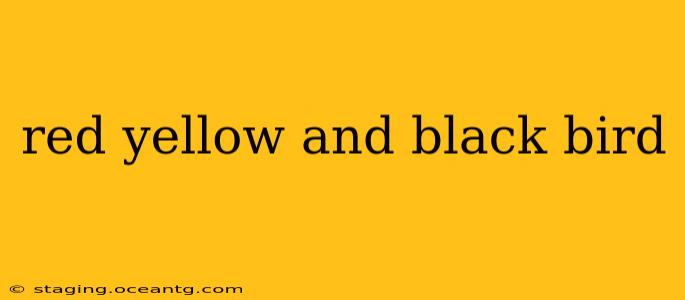The vibrant combination of red, yellow, and black feathers instantly catches the eye, making birds sporting this striking palette particularly memorable. But which species are we talking about? Many birds around the world boast this striking color combination, making identification a fun challenge for birdwatchers of all levels. This guide will explore several possibilities, helping you narrow down the options based on location and other identifying features.
What are some red, yellow, and black birds?
This question depends heavily on your geographical location. The specific species you’ll encounter will vary greatly depending on whether you're in North America, Europe, Asia, or elsewhere. However, some common examples of birds featuring red, yellow, and black plumage include:
- Northern Cardinal (North America): While predominantly red, male Northern Cardinals often display hints of yellow on their beaks and a black mask around their eyes. The females are a more subdued brown, but still show elements of red and may have yellowish tones.
- Baltimore Oriole (North America): This stunning bird features a bright orange-red body, black wings and tail, and distinctive white wing bars. The bright orange-red can appear quite yellow depending on the lighting.
- Black-headed Grosbeak (North America): Males of this species boast a striking black head, bright yellow underparts, and reddish tones on their wings and back. Females are more subtly colored, but still display yellow and reddish-brown.
- Red-and-yellow Barbet (Central and South America): This colorful bird is characterized by its predominantly red body with yellow patches, a black mask, and a prominent black bill.
- Red-breasted Blackbird (South America): This bird has a mostly black body with a striking red breast and hints of yellow on the flanks, particularly in the females.
- Black-faced Fire Finch (Africa): This small finch features a bright red head and breast, black face and throat, and yellow flanks.
This list is not exhaustive, and many other birds might exhibit a combination of red, yellow, and black, even if only subtly.
How can I identify a red, yellow, and black bird?
Accurate bird identification requires a multi-faceted approach. Don't just rely on color alone! Consider these crucial factors:
- Location: Where did you see the bird? Knowing your geographical location significantly narrows down the possibilities.
- Size and Shape: Is it a small, medium, or large bird? What is the general shape of its body and beak?
- Behavior: What was the bird doing? Was it foraging on the ground, in trees, or in flight?
- Song and Calls: Bird songs and calls are unique identifiers. Could you record the sound or describe it?
- Habitat: What kind of environment did you observe the bird in? Forests, grasslands, wetlands, etc.?
What is the size of a red, yellow, and black bird?
There's no single answer to this question. The size varies greatly depending on the species. Some, like the Black-faced Fire Finch, are quite small, while others, such as the Black-headed Grosbeak, are considerably larger. Always consider the size relative to other birds you've seen in the same area.
What kind of red, yellow, and black bird lives in [Specific Location]?
To answer this question accurately, please specify your location! Knowing the region will significantly refine the search and help identify likely candidates. Using online bird identification resources and entering your location and a description of the bird will prove extremely helpful.
Are there any poisonous red, yellow and black birds?
Most birds with red, yellow, and black plumage are not poisonous to humans. The bright coloration often serves as a warning signal to predators, indicating toxicity or unpleasant taste (aposematism). However, it's crucial to avoid direct contact with any wild bird, as they can carry diseases.
By carefully observing and recording the details mentioned above, along with consulting reliable bird identification resources and field guides, you'll greatly increase your chances of successfully identifying that striking red, yellow, and black bird! Remember, birdwatching is all about observation and learning, so enjoy the process!
